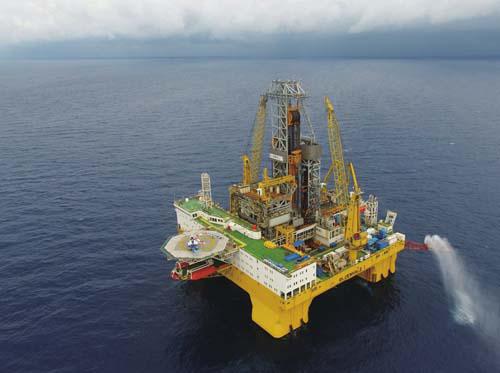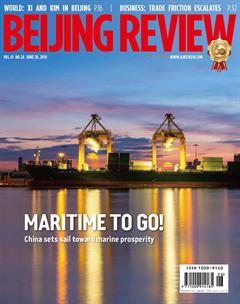TAPPING INTO THE SEA
By Yuan Yuan


After the 18th Shanghai Cooperation Organization Summit in the coastal city of Qingdao, east Chinas Shandong Province, Chinese President Xi Jinping embarked on an inspection tour of the province, visiting historic sites, marine labs, state-owned enterprises(SOEs) and villages. It was his second inspection tour of the province since taking office in 2012.
Shandong, literally meaning “east of the mountain,” is mostly known as a major agricultural province located in the east of the country. Its rich marine resources—with a coastal area of 159,000 square km and a coastline of 3,345 km that accounts for one sixth of the countrys total—have been overlooked until recent years when China started to make efforts to enhance its maritime strength. The coastal advantages of the province have thus been thrust into the limelight.
Marine development
The Qingdao National Laboratory for Marine Science and Technology (QNLM), the first place that Xi visited during his tour, was launched in 2015 and focuses on basic research as well as the research and development (R&D;) of cuttingedge technologies related to marine science.
With a total investment of 1.3 billion yuan ($200 million), the site covers an area of 150,000 square meters and has eight main labs involved in research ranging from marine and climate change to the evolution and protection of marine environments, and sustainable use of marine biological resources. It aims to become a world-class comprehensive marine research center and an open platform for collaborative innovation.
Xi reviewed the major frontier sciences, the independent R&D; of marine high-end equipment, as well as the promotion of military-civilian integration at QNLM. Two academicians from the Chinese Academy of Engineering working in the lab shared their marine dreams with Xi.
“I told the president that a new marine drug is very likely to be developed by China,”Guan Huashi, one of the academicians, said. The new drug, HS971, for the treatment of senile dementia, is expected to complete its tests next month.
As the developer of propylene glycol alginate sodium sulfate (PSS), a marine drug that has been commonly used as a heparinoid for the treatment of ischemic cerebrovascular and hyperlipidemia diseases in China for nearly 30 years, Guan explained that China has two ways of developing marine drugs. One is to follow the R&D; method in Western countries and the other is to follow tradi- tional Chinese medicine, which is a uniquely Chinese method.
“My dream is to build Chinas first ‘blue drugstore,” Guan said.
Wu Lixin, another academician introduced Chinas exploration of deep-sea resources and said the lab now is collaborating with scientists around the world to develop marine and climate broadcasting systems.
“To build China into a strong maritime country is our dream, which cant be achieved by just a few scientists,” said Liu Baohua, QNLM Deputy Director. Liu said the lab has established an ocean-drilling research vessel-sharing platform to allow scientists all over the country to use the vessels through an application. “This is a strong support for young scientists who want to go deep into the ocean but cant get access to such vessels,” Liu said.
Xi also visited the Yantai CIMC Raffles on June 13. He inspected submerged oil drilling platforms and other marine engineering equipment manufactured by the company. Bluewhale 1, the ultra-deep-water, semisubmersible, drilling rig built by the firm conducted successful tests in the South China Sea in May 2017. As the worlds most advanced oceandrilling design, the platform has the greatest operating and drilling depth in the world and can take part in deep-sea operations across the world. This is Chinas first success in mining flammable ice at sea, showing that China has mastered combustible ice mining technology.
According to the National Construction Plan for Marine Ranch Demonstration Zone for 2017 to 2025, unveiled on December 5, 2017, by the Ministry of Agriculture, China is planning to build 178 national marine ranch demonstration zones, including in five districts in Yantai.
The city rolled out strategies to develop offshore marine ranch equipment such as multi-functional ocean ranch platforms and an intelligent, informative and diversified management system. Furthermore, the city of Yantai will explore more technological co-operation opportunities with countries and regions along the Belt and Road and make efforts to facilitate the signing of an agreement for an Arctic offshore drilling complex project with Russia.
History and innovation
The Belt and Road Initiative is a golden opportunity for the province to develop its marine resources. Penglai, a county-level city in the wider Yantai area, used to be a starting point for the ancient maritime Silk Road. Xi visited Penglai on June 13 and noted that Chinas ancient, modern and contemporary history is a valuable Chinese treasure.

